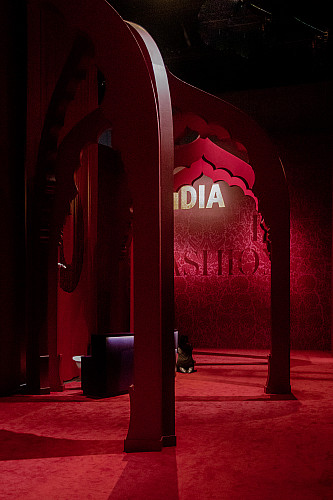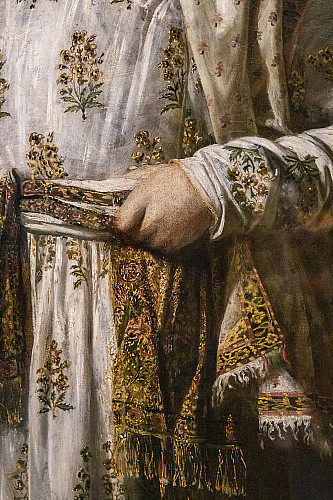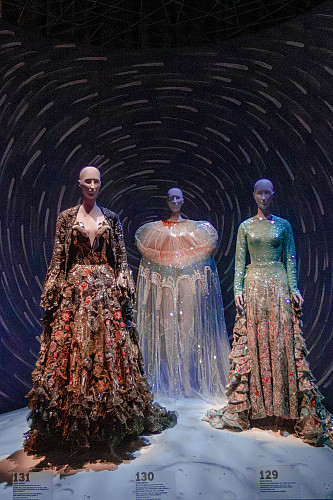Textual content by Shirin Mehta. With Pictures by and Inputs from Asad Sheikh.
1. The doorway to the exhibition featured a number of purple arches.
2. The sindoor-red partitions of the opening foyer had been lined with a scanned brocade weave.
The recently-concluded India in Trend: The Impression of Indian Gown and Textiles on the Modern Creativeness, at Mumbai’s spanking new Nita Mukesh Ambani Cultural Centre (NMACC), was a strong reminder of India’s affect on European vogue. Curated by vogue journalist and editor Hamish Bowles and blueprinted by Patrick Kinmonth, a designer of units for opera, and Mumbai-based architect Rooshad Shroff, the shows sprawled throughout a spacious corridor and spanned centuries of India’s sway over Western aesthetics. “Starting within the seventeenth century and persevering with to this present day, India’s affect on Western vogue has been an advanced and layered historical past of admiration, appropriation, exploitation and celebration” writes Bowles in his opening essay to the accompanying guide of the identical title.
Concerning the design of the area the place India in Trend was housed, Shroff says, “Patrick and I labored collectively to provide you with totally different scenographies for every of the sections. Loads of them (the backdrops to the reveals) draw reference from both the time interval or a second of structure from that exact time interval or perhaps a replication of a specific second in time, just like the recreation of the pavilion of the Nice Exhibition of 1851 that was held at Hyde Park in London in the course of the time of Queen Victoria.”
And curiously Deepthi Sasidharan, artwork historian, heritage advisor and founder-director of Eka Archiving Providers, who performed a walk-through with the Verve workforce, factors out, “There are two parallel storylines. One, the story of vogue. And the opposite is, after all, his (Kinmonth’s) referencing of India.”
The exhibition was offered towards a backdrop impressed by Indian motifs, stylised arches and a gap foyer styled predominantly in sindoor-red, with partitions embellished with a scanned brocade weave of a royal hunt in a procession crammed with all of the classics of the Western creativeness of princely India — tigers, deer, and riders. Some might need regretted the method being by way of a considerably anglophile lens. However regardless of the slant might need been, we’d like not lose sight of the significance of an exhibition reminiscent of this: a becoming documentation of the principal milestones of Indian affect on vogue which, in a way, set the document straight — and about time too.
1. Armadillo boots, famously seen in Girl Gaga’s Dangerous Romance music video, had been a part of the late Alexander McQueen’s closing assortment, Plato’s Atlantis.
2. A framed {photograph} of a blue-green elytra beetle, used within the Deccan beetle wing embroidery and stated to be the inspiration for the late Alexander McQueen’s closing assortment, held on the wall behind the Armadillo boots.
The ten sections aimed toward inserting India’s presence in international design by way of totally different lenses that ranged from inspiration to innovation. The first part principally checked out varied flashpoints of inspiration. “The affect of India’s tradition of gown and its very good craft traditions has been exerted past its frontiers for greater than a thousand years,” states the exhibition brochure. But the primary garment you encountered appeared considerably perplexing in that it gave the impression to be an outlier with no obvious connect with the nation. Jellyfish, the outfit from the late Alexander McQueen’s closing assortment, Plato’s Atlantis, consists of gown, leggings and Armadillo boots (made well-known by Girl Gaga) embroidered with iridescent enamel paillettes. A hyperlink to India is nevertheless established within the caption of a framed image of a blue-green beetle on the wall behind. It factors out the Deccan beetle wing embroidery, practised in India, because the scaly inspiration for the textile utilized by McQueen for his garment.
“Beetle wing embroidery was a lot sought-after within the 18th and nineteenth centuries. It unfold internationally, particularly England, the place it was thought of because the epitome of luxurious clothes. And McQueen was really impressed by it,” asserts Sasidharan, silencing sceptics. Nevertheless, having the ability to showcase such a uncommon object of vogue historical past right here nearly appeared like cause sufficient for its presence which highlighted the state-of-the-art preservation system that now permits us to see a garment in Mumbai as a substitute of getting to journey to museums world wide.
Court docket fits made utilizing silk brocade, zardozi, glass beads and tinsel, circa 1830. On mortgage from the Royal Ontario Museum, Toronto.
Moreover the McQueen ensemble, these first six rooms included two boys’ court docket fits from the 1830s fabricated from brocade and embellished with zardozi embroidery, and a Federico Forquet dhoti-inspired jumpsuit of printed silk from 1967. Of curiosity had been a silk lamé organza drape gown from the Autumn/Winter 1956 assortment by Dior, paired with a particular Tarun Tahiliani draped creation in crinkle tulle from 2020. Each use sari drapes as an inspiration level, greater than six a long time aside.
Two clothes — by Christian Dior, 1956 (left) and Tarun Tahiliani, 2020 (proper) — underline the flexibility of the sari drape.
It was on this area that we found what Sasidharan conjectures is without doubt one of the oldest clothes offered right here — Captain John Foote’s jama (gown). “The jama has been such an inspiration and it was later taken on as a girls’s silhouette as nicely,” the heritage advisor says. From 1750 and fabricated from the best muslin with block printing and embroidery, the garment has been offered along with a portrait of the person sporting it, thus throwing into focus that British males did embrace Indian textiles and, at occasions, the silhouettes as nicely. “This truth wasn’t publicised as a lot as a result of it wasn’t a lot of a colonial narrative to place on the market,” provides Sasidharan. “However the truth is that the majority British gents who lived and labored right here, needed to adapt to the warmth.”
1. A model is wearing Captain John Foote’s jama (gown), patka (a small scarf used as a sash across the waist) and scarf, as seen within the portray.
2. Captain John Foote’s ensemble, painted between 1761 and 1765 by Sir Joshua Reynolds in London.
Following a small part with a fleeting homage to Bollywood that appeared inevitable, two segments, “Gathered in a Mughal Backyard” and “The Lengthy Shadow of Muslin”, centred across the Coromandel coast’s chintz kalamkaris and Bengali muslins, respectively. These sections labored in tandem to convey to life the early colonial creativeness of India. “The huge textile enterprise contributed to creating the Mughal Emperor…the richest monarch on the planet.’ And offered a prize that the rapacious East India Firm was eager to grab” Bowles writes. The exhibition brochure states that the recognition of the material within the 18th century led to a ban on its import from India “and that subsequent industrial exploitation of imitations offered again to India solely provoked a larger ardour for the originals”. Shroff expounds, “There may be quite a lot of historical past intertwined with politics and the thought of how materials and clothes had been enjoying into a bigger dialog and creating an affect on society.”
The chintz room, with water ripples printed on the carpet and a sound projection that enhanced the sensation of strolling in a backyard, featured a number of items loaned by The Artwork and Folks of India (TAPI) Assortment in addition to a quilted “banyan” coat worn by George IV when he was the Prince of Wales. “It’s quintessentially an Indian silhouette for an Indian man. However this was worn by British males,” Sasidharan enlightens. Eight clothes together with clothes with hooped skirts, circled a Rahul Mishra creation, the place the embroidery has been impressed by chintz. An fascinating truth is that the exhibition featured commissioned works by some designers, deciphering classic kinds in a contemporary context; this included the Tahiliani drape talked about earlier in addition to the Mishra conception.
Balloon sleeve particulars of a woollen gown with an embroidered chintz sample, commissioned to Rahul Mishra. An embroidered chintz Palampore from the TAPI Assortment might be seen behind.
“I really like the entire cycle of various methods that chintz as a cloth has gone by way of. From being painted and hand printed utilizing pure dyes to being mass produced utilizing mechanised printing. It was fascinating to see the entire journey of chintz come alive; with the Palampore textiles from the TAPI Assortment, to the European clothes to the latest fee of the embroidered chintz robe by Rahul Mishra,” says textile revivalist and curator Lavina Baldota.
The phase on Indian muslin, offered in a round room below a large parasol, underlined its reputation in the course of the Regency interval. The material, although related to “humble utilization” as associated within the brochure, “made its means into the trendy milieu within the early 19th century. Generally embroidered, typically plain, it introduced an Indian summer time to the West”. A lot of the Jane Austen classics we grew up studying had girls strolling in gardens with cream-coloured parasols that includes this material. 4 basic empire-line clothes had been paired with an Abu Jani and Sandeep Khosla chikankari embroidered gown from 1993 and a Uncooked Mango mulmul sari from 2017.
The “Lengthy Shadow of Muslin” part featured a cotton muslin sari by Uncooked Mango; right here it’s juxtaposed with an empire-line cotton muslin European robe from the early nineteenth century.
In “India’s Attract Meets Paris Couture”, within the subsequent three sections, we encountered a exceptional array of clothes from French couture homes Chanel, Christian Dior and Yves Saint Laurent — which revealed the essence of India. Chanel, the quintessential French label, got here first with a formidable assortment starring items from Gabrielle Chanel herself, a uncommon deal with for vogue lovers in India. At Dior, what occupied satisfaction of place was the enduring Lahore gown made by Christian Dior himself and a extra structured gown in Marc Bohan’s attribute inflexible simplicity titled Koh-I-Noor adopted by an embroidered waistcoat and trousers by Maria Grazia Chiuri, the home’s present artistic director for girls’s traces. Additional, former artistic administrators, John Galliano and Gianfranco Ferré, had been aptly represented.
1. An Yves Saint Laurent ensemble that explores Indian bejewelled motifs and the Nehru collar by way of a silk shantung night go well with, circa 1982.
2. Yves Saint Laurent’s 1982 Summer season couture assortment was impressed by the grand Mughal model; the set design of the part devoted to him, was impressed by Indian stepwells.
But it surely was the final of the French trio, Saint Laurent, who had probably the most putting set. The room featured gridded partitions in copper-hued metallic that reached as much as the ceiling of the exhibit corridor, with the items displayed in alcoves on the partitions. The design was impressed by the stepwells of India. “This was really one of the crucial technically difficult areas to create as a result of each single rod was hand-soldered and welded collectively to type the area,” Shroff muses. “We wished to create a really mild, nearly see-through really feel so that you just would not have the solidness of the stepwell but you’ve gotten its total silhouette in order that the garments stand out.” On the centre of the room was a couture creation from 1982, the place the late designer sought inspiration from European sketches of Mughal costumes, leading to turbanned appears to be like with bolero jackets and huge skirts in silk faille and silk moiré.
Architectural particulars between two sections of the India in Trend exhibition — “Yves Saint Laurent” and “Journey of the Sari”.
Forward of the garments room, a brief hall lined with tables with sketches by Saint Laurent himself, featured the designs displayed within the earlier room. The dim hall was illuminated by a brilliant mild on the finish the place Isha Ambani Piramal’s Valentino wedding ceremony lehnga, a surprising piece in guipure lace with gold foil work that imitates the feel of zari embroidery, was displayed within the subsequent part, titled “Valentino — Marriage of East and West”.
Time now to pay homage to that iconic garment, the sari, in a bit all by itself. The sari, styled as a gown, by Mainbocher was sourced from the MET (Metropolitan Museum of Artwork), New York. Stylised drapes impressed by the sari might be seen in a Givenchy gown and two items by Cristóbal Balenciaga. A pallu (the unfastened finish of a sari) thrown over the higher physique at a 45-degree angle was the idea for a lot of Madame Grès’ works. A gown by Paul Poiret (that includes a skirt in sari material from 1922), a pleated sari-inspired gown by Elsa Schiaparelli from 1939 and an precise sari commissioned to Christian Dior in 1953 by an nameless shopper, had been on show.
1. The opening piece for the part, “Journey of the Sari”, was a sari gown in metallic jersey material materials by Tarun Tahiliani.
2. Elsa Schiaparelli’s interpretation of the sari by way of a gown that dates again to 1939. It’s stated to be impressed by her encounter with Princess Sita Devi of Kapurthala on her go to to Paris in 1935.
The exhibition area then opened out into a big corridor modelled after the Nice Exhibition of 1851 which had showcased items from internationally. The set design had been amazingly recreated from the unique exhibition, proper right down to the flat lays, the standing reveals, and, after all, the arched glass ceiling (the unique constructing had been known as Shalimar). “In a typical museum, you’re dictated by room sizes and the structure,” says Shroff. “This specific case was totally different as a result of we had been working in a conference centre geared in direction of museum specs…. We had 50,000 sq. toes to work with….” A wide range of intricate Kashmiri weaves, experimental footwear by Christian Louboutin, revival crafts by Ritu Kumar and a gown by Charles Frederick Value had been showcased towards an intricately hand-embroidered backdrop of a banyan tree, which took about 80 kaarigars (artisans) over a month to create.
1. A Rudi Gernreich gown, impressed by the hippie motion within the ’60s, utilised the Rajasthani bandhani tie-dye textile.
2. The “Hippie Path” part was composed of a round set of purple mannequins, dressed by Western designers who’ve primarily based their work on the imaginative freedom and mysticism that India symbolised.
3. Resembling the curved drape of the dhoti, this Madame Grès jumpsuit in silk taffeta — on mortgage from the Costume Institute on the MET — highlighted the designer’s fashionable interpretations of India.
4. The second part of the “Hippie Path” featured six items from Manish Arora, John Galliano and Dries Van Noten. Right here, a sari-dress (proper) from Galliano’s 2002 Holi-inspired assortment is positioned subsequent to a cape gown by Arora (left).
The 2 components of the “Hippie Path” transported us to the tumultuous period of the ’60s with Zandra Rhodes, Rudi Gernreich and Thea Porter items, all imagined in an thought of Rajasthan, the nomadic religious imaginative and prescient of India throughout that point. The setting of the second half was impressed by the Jantar Mantar observatory, with six clothes perched above the bottom in round packing containers. Two of Galliano’s wildest appears to be like from the 2002 Holi-inspired assortment had been current, together with two silk ikat clothes by Dries Van Noten and a cape gown by Manish Malhotra. Shroff credit inspiration for the backdrop to a time when the West “fed up post-war, flocked to India and significantly to places like Jantar Mantar looking for an alternate actuality”.
Appropriately, India in Trend concluded with a showcase of present Indian designers. In any case, “The top level of the exhibition is that Indian vogue has arrived, or a minimum of that’s the messaging,” Sasidharan stated. A tableau with Sabyasachi’s bridal put on, items by Abu Jani and Sandeep Khosla, Manish Malhotra, a show with Rahul Mishra’s space-inspired clothes, represented the classics of mainstream Indian excessive vogue.
1. The opening showcase for the ultimate part of the exhibition offered Sabyasachi Mukherjee’s white bridal put on.
2. The closing show of the exhibition featured three space-inspired ensembles with hand embroideries, by Rahul Mishra.
The exhibition enthralled with its units and the delight of viewing clothes by no means earlier than been capable of be seen within the nation. For the primary time, a gamut of establishments and archives from world wide loaned collections, starting from the Royal Ontario Museum to the MET. “You break it down…there’s a cultural layer, there’s an economics layer — there’s equipment, costumes, there are world occasions that had been taking place…. I’m accustomed to quite a lot of the milestones that had been offered on this exhibition, and it’s the convergence of over 250 years of historical past and politics and actually a view of the world scape by way of vogue….” Sasidharan concludes.

















